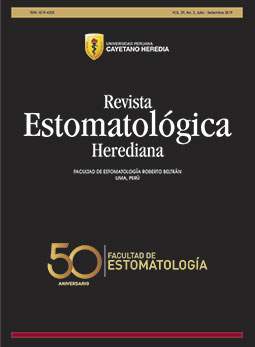Pyogenic Granuloma: Case report of a reactive hyperplastic lesion with tumor appearance.
DOI:
https://doi.org/10.20453/reh.v29i3.3606Keywords:
Pyogenic granuloma; peripheral ossifying fibroma; giant cell granuloma.Abstract
Pyogenic granuloma is a reactive lesion in response to different local factors, including traumatism, caries dental, hormonal imbalance or poor oral hygiene, which produces an inflammatory proliferation of connective tissue. Pyogenic granuloma is frequently located in oral cavity (gums, tongue, hard palate, lips, and floor of mouth) and skin. Clinically, it presents as a vascularized hyperplastic lesion with a slow-growing pedicled or sessile base of variable size and slow growth. Histologically, shows proliferation of endothelial tissue to a vascular network with signs of chronic inflammation and granulation tissue. This case report aims to identify the clinical, imaging and histopathological characteristics of Pyogenic Granuloma with tumor appearance in the oral cavity in an adult patient of the Clínica Dental Docente Cayetano Heredia in 2017. Clinical and histopathological characteristics of granuloma allow a specific diagnosis, given that their differential diagnoses are similar. The treatment options for pyogenic granuloma include excision, laser pulsed-dye, intralesional injection of ethanol or corticosteroids, sclerotherapy with sodium tetradecyl sulfate, and cryosurgery. Reactive hyperplasia may present a tumor appearance that is ruled out by anatomopathological study. Choosing the correct approach and treatment requires a proper clinical and histopathological diagnosis.
Downloads
Downloads
Published
How to Cite
Issue
Section
License
The authors retain the copyright and cede to the journal the right of first publication, with the work registered with the Creative Commons License, which allows third parties to use what is published as long as they mention the authorship of the work, and to the first publication in this journal.























